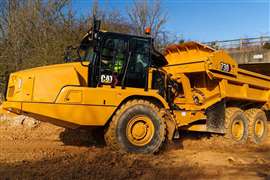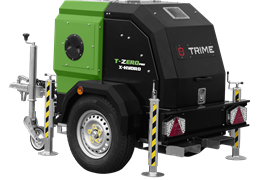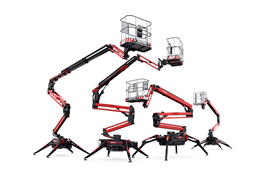Electric earthmoving equipment: the latest models
22 August 2023
As the drive to lower emissions continues, OEMs are innovating with electric earthmoving equipment at an increasing pace. Lewis Tyler reports.
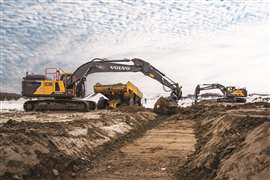 The EC230 is the first electric offering in the mid-range from Volvo. (Photo: Volvo)
The EC230 is the first electric offering in the mid-range from Volvo. (Photo: Volvo)
While the number of diesel-powered machines still outweighs the number of electric machines on the market, it is undeniable that the demand for alternative-powered solutions means that it has a place in the sector.
In fact, a report (see box story on mini excavators) found that the electric construction vehicle market is taking off imminently and will have a 10-year CAGR of 37%.
While ongoing developments such as hydrogen look promising in the long-term, electric machines are certainly filling the gap for users looking to reduce emissions.
And, although some would argue that electric power doesn’t offer the same level of performance, developments in recent years have seemingly closed the gap.
Electric excavators
Take the 23-tonne EC230 electric crawler excavator from Volvo for example. The machine, the company’s first electric offering in the mid-range, has been piloted in Europe and South Korea and is now set for its entry into North America.
It is said to offer low noise and zero emissions while delivering the same performance but with an “improved environment for the operator,” according to Volvo.
Other benefits include less vibration, improved response (instant torque), less dust and heat, while its lithium-ion batteries have been designed to work a full eight-hour shift.
The company says that operators who have used the excavator reported similar digging force to its diesel equivalent, but with a faster cycle time.
Fredrik Tjernström, responsible for electromobility solutions sales at Volvo CE, says, “Partnership is how we can accelerate our journey towards emission-free jobsites. We have powerful and reliable solutions like our EC230 Electric and L120H Electric Conversion providing all the benefits of electric equipment: zero exhaust emissions, near silence and more comfortable operation.
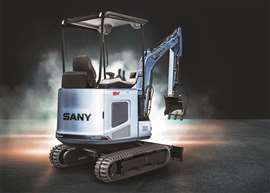 The electric motor of the SY19e is said to deliver a peak output of 15kW. (Photo: Sany)
The electric motor of the SY19e is said to deliver a peak output of 15kW. (Photo: Sany)
“But it is by collaborating with like-minded partners, who are aligned with our mission to build a better world that we can really drive the transformation of our industry in a much more holistic way.”
Another new launch in the excavator space is the SY19E from Sany. The machine is equipped with battery power that is said to last for an entire working day and reduce both pollution and noise emissions.
Described by Sany as compact and versatile, the machine weighs 1.8-tonnes and comes with an electric motor that delivers a peak output of 15kW, along with an efficient load-sensing hydraulic system.
Commenting on the launch, Leigh Harris, business development director of Sany UK says, “The SY19E is a game-changer in the mini excavator market. We believe that it will set a new standard for performance and efficiency in this segment of the industry.”
Are electric mini excavators a better choice than diesel?
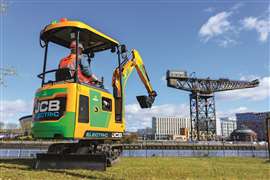 One of Sunbelt’s JCB electric mini excavators, pictured on the Clyde River in Glasgow, Scotland.
One of Sunbelt’s JCB electric mini excavators, pictured on the Clyde River in Glasgow, Scotland.
According to a research paper by IDTechEx, electric mini excavators are now seen as a “a better choice” than diesel in the current market.
The “Electric Vehicles in Construction 2023-2043” report predicted that the electric construction machinery market was about to “take off” with a 10-year compound annual growth rate (CAGR) of 37%, although this is starting from a small base, with electric machine sales considerably lower than diesel.
Mini excavators are one of the biggest construction machine markets by volume and the report suggested that their small size and lighter workloads made them an ideal fit for electrification.
It went on to offer three important reasons “why electric should be an easy choice over diesel”:
The first reason, “Equal or better performance”, stated that electric machines have “equivalent or even superior power when compared with their diesel counterparts”
Its second point, “Better environment for workers”, the research cited zero exhaust emissions as a major benefit of transitioning to electric. “With open cabins and stationary vehicles, the air quality that an excavator operator and surrounding workers are exposed to can be very poor,” the report said.
Its third and final point says that electric machines are “Cheaper” and could offer “a significant reduction in the total cost of ownership” over diesel equivalents.
However, the report also highlighted challenges facing electric mini-excavators. In particular, it cited uncertainty as to whether battery prices will continue to fall and peak power performance when compared with diesel counterparts.
Hitachi Construction Machinery has recently launched new electric models in the excavator segment with the ZX55U-6EB mini and ZX85-6EB compact.
Part of its Zaxis range, Hitachi says the ZX55U-6EB comes after it saw “growing demand for electric equipment to work on low or zero-emission job sites” and the success of its eight-tonne ZE85 electric excavator.
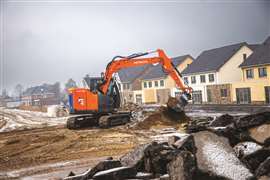 The ZX55U-6EB is part of the Hitachi Zaxis range. (Photo: Hitachi)
The ZX55U-6EB is part of the Hitachi Zaxis range. (Photo: Hitachi)
Described as providing reduced noise levels, enhanced efficiency, fewer maintenance requirements and less downtime than conventional models, the ZX55U-6EB allows users to operate it using battery power (via 39kWh lithium-ion batteries) or via a wired connection to a CEE 400VAC 3-phase power source.
Bobcat has also recently introduced a new mini-excavator with its E19e 2-tonner.
The E19e – an electric version of its E19 internal-combustion (IC) model – offers zero emissions, low-noise operation and comparable levels of performance to its diesel-powered counterpart.
The Bobcat E19e features the same profile, external dimensions and comparable performance as the E19 mini excavator. It features a 3.5-hour battery capacity and can be recharged quickly using a super-fast charger, meaning that, by topping up the power during work breaks, the machine can be used all day for the majority of typical applications.
Scott Park, Doosan Bobcat CEO, says, “With the introduction of the E19e, Bobcat has expanded its larger-size electric line-up of zero emission and quiet machines that can match the excellent performance of our conventional models.”
Sustainable loaders
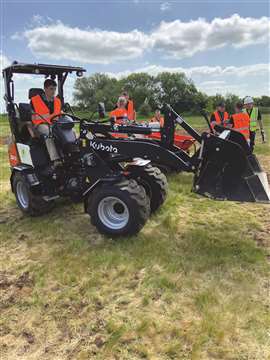 The RT220-2e is powered by a 48V system with modular 260Ah lithium-ion batteries. (Photo: IRN)
The RT220-2e is powered by a 48V system with modular 260Ah lithium-ion batteries. (Photo: IRN)
Japan-based OEM Kubota is well known for its production of mini excavators, but at the time of writing it is yet to fully make the jump into the electric space. Speaking to IRN earlier this year, Rob White, construction division manager, Kubota UK, said the company “didn’t see it as a race to be first.”
However, it is one of many notable producer of electric earthmoving machines and recently announced the launch two new electric RT compact wheel loaders.
The RT210-2e and RT220-2e are both powered by a 48V system with modular 260Ah lithium-ion batteries as standard and can be recharged via a Standard Integrated 40A on-board charger in seven hours. An optional supercharger can charge the machines fully within 90 minutes.
The RT210-2e’s long loader arm has a reach of up to 2,852mm, while the RT220-2e shorter loader arm has an increased lift capacity of up to 1,140kg.
Elsewhere in the loader space, JCB introduced its first fully electric wheeled loader in June. Part of the OEMs E-TECH range, the 403E is said to come with the largest standard battery pack in its class, with a 20kWh capacity.
Commenting on the launch, JCB chief innovation & growth officer Tim Burnhope said, “The 403E machine brings the proven JCB E-TECH powertrain technology into a compact wheeled loader machine. With a 20kWh lithium-ion battery, it has a 2729kg operating weight and 618kg payload in a package that can deliver 20kph performance.
“The machine has dedicated control modes for precise operation - making it a great choice for agricultural and construction applications.”
On the wider E-TECH range, Burnhope said it brings a “series of benefits to the user” including minimal operating noise which allows operators to “communicate safely and with people around them in sensitive environments.”
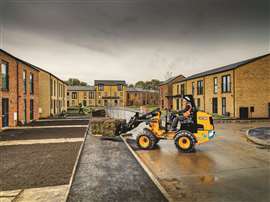 JCB introduced its first fully electric wheeled loader in June. (Photo: JCB)
JCB introduced its first fully electric wheeled loader in June. (Photo: JCB)
Burnhope added that machines in the range are “comfortable places to work, as no mechanical engine means that vibrations are reduced to a minimum. With zero emissions at the point of use, our E-TECH machines enable working in enclosed environments as well as helping to reduce carbon footprints. With flexible charging options a typical full day’s work is possible on a single charge while an optional fast charger is available when the machines are on more demanding duties.”
Following the launch of its Bobcat T7X, the world’s first all-electric compact track loader, Bobcat publicly unveiled an all-electric skid-steer loader during ConExpo-Con/Agg 2023 in Las Vegas.
The S7X is a concept all-electric machine powered by a 60.5kWh lithium-ion battery and is equipped with electric drive motors and utilises ball screw actuators for lift and tilt functions, eliminating the need for hydraulics.
It is said to be able to last for up to eight hours on a single charge depending on the application, while full charge takes 10 hours, according to the company.
Toro has also recently launched an updated model in this space with its eDingo 500 compact utility loader. Initially launched in 2020, it is fitted with a HyperCell Power System from Toro that can “match the power of traditional internal combustion-powered products with zero engine-exhaust emissions and less noise.”
It also offers eight-hour continuous runtime, while maintaining a 234kg Rated Operated Capacity and its ability to fit through tight spaces.
Its controls have been upgraded which means it can now be operated via Toro’s one-handed traction controls. Another key benefit, according to the company, is its user-friendly design, which allows for “smooth and precise movements at any skill level”. This, says Toro, is particularly useful for the rental market, where “any operator can quickly learn the machine.”
Electrification: is it the future?
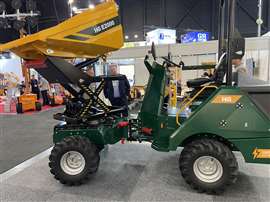 The HGE2000 two-tonne electric dumper. (Photo: IRN)
The HGE2000 two-tonne electric dumper. (Photo: IRN)
While electrification is a major trend currently within construction, especially within compact machines, what does the future look like?
According to Nikolaj Birkerod, CEO of Danish OEM HG, the company is seeing interest in electric machines rise in the European market; “What we see is there’s a lot of interest from all European countries. I would say that there are bigger dumper markets than others, but we see a lot of interest and that was reflected at IRE.
“We had some very interesting meetings in several big countries about the possibilities. However, I would say that it’s a little bit market specific and down to the specific company because few people need an electric two-tonne, but everybody knows that we need to start reducing carbon emissions and improve working conditions”.
The company itself has committed to become an exclusive provider of electric machines. As well as its previous launches, the HG E1000 ‘Super Skub’ and HG E1000 ‘Super Skub’ High Tip mini dumper, HG recently announced the launch of its two-tonne electric dumper the HGE2000.
Elsewhere, Volvo says it is seeing a “huge difference between market readiness when it comes to electrification,” and points towards a fast-tracked governmental incentive in Romania that aims to promote electric construction equipment.
In terms of the role electric will play in the future, Burkhard Janssen, product manager special applications and new technologies at Hitachi Construction Machinery (Europe), says that electrified construction machinery is “not the solution, but part of the solution towards a sustainable future.”
He goes on to say that the biggest challenge in the development of electric equipment is the cost compared with conventional machinery. “To drive the uptake of alternative power sources, such as battery, in construction equipment, TCO is an important factor, as well as public funding and a feeling of being responsible for a clean and sustainable future,” he says.
What is perhaps most interesting is that three companies, HG, Volvo and Hitachi all say that Norway are at the forefront of pushing the electrification agenda, while the Netherlands and Sweden are also mentioned.
Why North America is ready for electric construction equipment
 Stephen Roy, president of Volvo Construction Equipment, Americas. (Photo: Volvo)
Stephen Roy, president of Volvo Construction Equipment, Americas. (Photo: Volvo)
North America is ready for electric construction equipment, contrary to perceptions in some quarters that appetite for the machines lags that in Europe. That’s according to Stephen Roy, president of Volvo Construction Equipment, Americas.
Speaking to International Construction, Roy said he was seeing pockets of demand for electric machines across the USA, and that it wasn’t just their lower carbon emissions that was generating interest but the lower levels of noise and vibration.
When asked if electrically powered machines were likely to prove less popular in the North American market than in Europe, Roy said, “There are parts of the European market that are more progressive than other parts of the European market, so it’s not even the same in Europe and I think it’s the same here.
“We have states with high population density and when you go further towards the West Coast you get a lot more focus on environmental standards and more early adopters.”
Roy said he saw the trend to electrically powered machines continuing in the compact equipment market but also moving into the mid-range.
STAY CONNECTED



Receive the information you need when you need it through our world-leading magazines, newsletters and daily briefings.
CONNECT WITH THE TEAM










